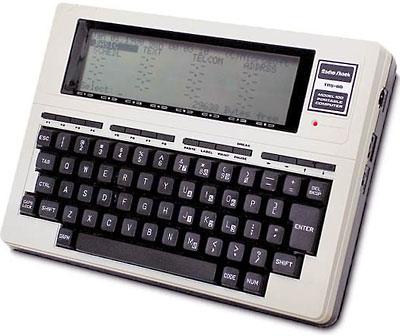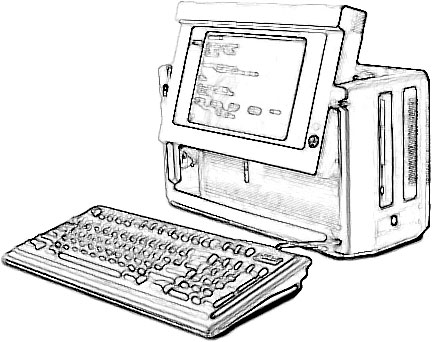1998 – Back in March 1992, MacUser magazine ran an article comparing past and then-current Macs. One comparison was the original Macintosh with the Quadra 900: 8 MHz 68000 vs. 25 MHz 68040, 128 KB RAM vs. 4 MB to 256 MB, no SCSI or hard drive vs. several internal drive bays and an external SCSI bus, etc.
The next question: What would the Macintosh be like in another eight years. This is Part 3 with Henry Bortman’s speculations, followed by my comments (indented).
If you missed them, read Part 1 and Part 2.
You’ll be able to have your Mac at your desk if you need to, but you’ll be more likely to carry it in your shirt pocket. Some models will hang on the wall of your conference room, where the white board lives today. Pen-based models will replace the artist’s easel or the draftsman’s desktop.
Maybe Bortman read too much science fiction. ;-)
Seriously, it was the 1984 novel, The Mote in God’s Eye, that introduced the idea of a handheld computer. From the early 1980s onward, the computer industry has been working to invent a viable handheld – and it’s getting closer all the time.
 The first models were from Sharp, Radio Shack, and Panasonic, with a one-line 20-40 character LCD display and a tiny keyboard. You could even program them in BASIC. Later came the Epson Geneva (8 lines of 80 characters), the Radio Shack Model 100 (8 by 40), and other technological oddities.
The first models were from Sharp, Radio Shack, and Panasonic, with a one-line 20-40 character LCD display and a tiny keyboard. You could even program them in BASIC. Later came the Epson Geneva (8 lines of 80 characters), the Radio Shack Model 100 (8 by 40), and other technological oddities.
Adam Osborne invented the transportable computer around 1980. Compaq made the first PC compatible transportable computer within a year of IBM introducing the PC. These were real computers, unlike the earlier handheld toys. And they were huge, about 40 pounds and the size of a suitcase.
 Luggable gave way to lunchbox, gave way to notebook, gave way to laptop – which is where most of the portable computing power is today. The PowerBook G3 Series probably represents the best and biggest practical model today (any smaller and you’d have to sacrifice that killer 14.1″ screen).
Luggable gave way to lunchbox, gave way to notebook, gave way to laptop – which is where most of the portable computing power is today. The PowerBook G3 Series probably represents the best and biggest practical model today (any smaller and you’d have to sacrifice that killer 14.1″ screen).
But the real innovation is again in the handheld market. Apple’s Newton was a limited success, which Apple chose to sacrifice in favor of continued corporate existence. (And it looks like the Newton technologies may make a comeback in Apple’s consumer portable.)
Microsoft created Windows CE, which spawned an industry of handheld computers that would be immediately familiar to Windows users. Then came the Palm Pilot, which carved out a niche apart from Windows or the Mac OS – a niche which has grown to dominance in the handheld area.
But I don’t think we’ll see a handheld or shirt pocket Macintosh soon, if ever. Apple’s been through some rough times and needs to focus on areas it knows, such as desktops and portables. Going once more into handhelds – at least until the company is firmly established on a solid financial footing – isn’t in the cards.
Apple probably could do it, but it is unlikely to invest limited resources in an area already dominated by Microsoft and the Palm Pilot.
What about white boards and pen-based LCD tablets? Count on them, but you probably won’t see a white board with an Apple logo. The tablet? It could come as early as 1999 with the rumored consumer portable. Not quite a graphics station or drafting table yet, but a strong step in that direction.
Your computer display will be a full-color flat-panel LCD with a resolution of 150 DPI (dots per inch) or greater. Images will have the clarity of high-definition television. Printing will become a special-purpose activity; most information will be transferred electronically.
Six months ago I would have scoffed at the idea. Color LCDs were simply too expensive. Then I started reading reviews in PC Magazine and Macworld. Today’s LCD “monitors” are high resolution (1024 x 768, 14″ to 15″) and starting to drop below US$1,000. IBM has 150 DPI screens and is working toward 200 DPI. We’re starting to see larger screens (up to 20″) with higher resolution (up to 1280 x 1024, but expect 1600 x 1200 in 1999). The industry is creating a standard digital interface for LCD monitors, which will eliminate digital-to-analog (VGA is analog) conversion in your computer and analog-to-digital conversion in the screen – and further reduce prices.
It’s quite possible we’ll see $500 LCD monitors by the end of 1999, along with larger ones we can hang on the wall for presentations or watching TV.
Printing will never become a special-purpose activity. Despite over a decade of pushing for “the paperless office”, it simply won’t happen. Hard copy is too important to abandon.
But we have probably already reached the point where most information is transferred electronically. I get my news, values on my 401(k) plan, and mail electronically for the most part. Sure, I read magazines, but most of what’s in print I’ve already seen on the Internet.
The Internet and World Wide Web have turned us into a highly wired society, probably much more so than almost anyone would have predicted in 1992. But Bortman definitely scores points for flat panel displays and electronic data transfer.
And price? You’ll be able to get a device with this “basic” capability for less than $1,000, allowing, of course, for inflation adjustments – but you’ll have to pay a bit more for the Holodeck option.
The last comment shows Bortman has at least one foot in the realm of science fiction. And wouldn’t we all love a Holodeck at the end of a long day at work? Computer, take me to Aruba.
Will the Mac 2000 sell for under US$1,000, or is that science fiction, too?
A few months ago, I stated that we wouldn’t see $500 PCs this year. I was wrong. By combining enough of last year’s parts, some computer manufacturers are offering under-powered computers for very attractive prices, some under $400.
But as anyone whose been following this industry for more than two years can tell you, computers are a moving target. The same $1,300 that paid for my Centris 610 in 1993 (20 MHz 68LC040, 4 MB RAM, 80 MB hard drive, no CD-ROM, no ethernet, no monitor) would by an iMac today (233 MHz G3, 32 MB RAM, 4 GB hard drive, CD-ROM, 10/100 ethernet, 15″ multiscan monitor). And just a few years earlier, I was selling the Mac Plus for $1,300 at ComputerLand (8 MHz 68000, 1 MB RAM, no hard drive, CD-ROM didn’t exist, LocalTalk networking, 9″ black-and-white screen).
In other word, things change – and quickly. The iMac 2000 will probably run a 500 MHz G4, have 128 MB RAM, a 16 GB hard drive, DVD, a 1280 x 1024 LCD monitor, and FireWire. On top of that, it may well sell for under $1,000. It will certainly sell for less than today’s iMac.
Summary
Bortman hit the nail on the head as often as he missed – and some of those misses were close (solid state RAM cards v. Zip and Jaz drives). Each reading of his article reminds me how much things have changed while the Mac OS remains as easy to use as it was in 1992. And each month does seem to bring closer some of the “science fiction” ideas from 1992.
The biggest difference will be Mac OS X and its descendants. Nobody knows how much software will break, how many programs will have to run in an OS 8 compatibility box. Compared with the switch to PowerPC with almost perfect 680×0 emulation, OS X remains uncharted territory.
But I’m looking forward to exploring it.
Besides, I’ll still have my old Macs to run all the old programs on. They’ll become museum pieces in a living, working Mac museum, hands on tools for my family in the Year 2000 and beyond.
Keywords: #mac2000
Short link: http://goo.gl/nBZ6nR

